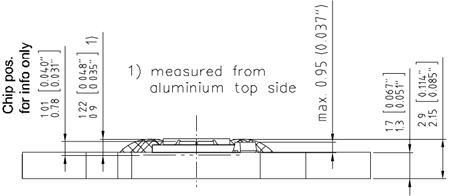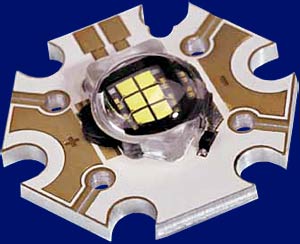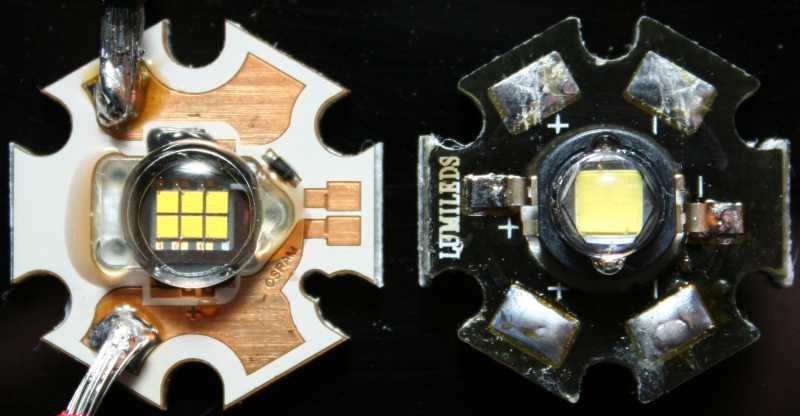The high-end project
Sometimes in your diver life there may come the wish for a diving lamp with outstanding lightoutput. Looking at hallogen the end is mostly 50W cause the accupack can´t stand more drain. So you may choose the bright but expensive HID technic. Aim of this project was to build a diving light that can compete with all high end HID light availible - but it is based on LEDs!
You may ask why LED and not the comon HID techic? Well, HIDs have some build-in disadvantages compared to the other bulb typs. HID is a plasma lamp that has to be ignited and kept to life with a complicated and expensive electronic. Besides that HID needs some time to reach its full lightoutput and from this point it should not be shut down till the end of the dive cause every HID bulb has only a certain number of starts till its end of life. All this problems are unknown to leds. They give you the full power starting with the first millisecond and the on/off switch has no impact on their lifetime. And this lifetime is over 50.000 hour burntime! It is likely that a led will be never swaped in a diving lamp life.
The problem building with leds is about something other. While you can simply choose bigger HID bulbs for more lightoutput the modern led emitter has some technical limitations regarding the maximum power. If you would use the well known luxeon 3W emitter to build the desired high-end lamp you have to sum-up many, many of them to reach the same lightpower. But all this emitters where not focusable in a carryable form factor (through one builder has tried it with the result of a big wall of dimm white :-) ). This project goes new ways by clustering some so called multichip emitters, that integrate more than one LED chip in one small package. So you have a reasonable space for focusing the light and you get tons of light lumens. This project uses the new OSTAR LED from the german OSRAM. This chip uses up to six led chips in one package and features some of the most sophisticated led technologies available today (got the german future prize 2007 for it). That means up to over 4.000 lumen(!) of light will come out of four of this leds. For comparision a 20W hallogen bulb puts out around 300 lumen. It would be funny to know what comparible hallogenpower would be calculated for this kind of lamp. :-)
Now all this lumen have to be collaminated and should come out in front of the lamp. Even here this lamp goes new ways cause the common plastic lenses (TIR optics) are not able to focus the quite big light emitting surface of the OSTAR or if they can they are much to big to fit into the desired lighthead with only 50mm diameter.
The light focus job is done by some special aluminium reflectors in combination with tiny glas optics for optimizing the collimation. Reflectors have the great advantage of a far better efficiency with over 97% (50-80% for TIR optics) with special alu coatings. Besides that a reflector produces a well defined hotspot and some useable light in a much wider corona compared to the TIR optics.
The used reflectors in this project have a coated surface and a special kind of skin on it that creates a very intensive hotspot with a smooth transition into the corona without any bad artefacts like dark rings. The glas optic on top of the reflector catches about 20% more light and directs it strait forward.

The OSRAM OSTAR emitter
It is one of the brightest LEDs you can buy at this time. The emitter star itself has exact the same size like the well known luxeon 3/5W emitters. Only the emitting surface is slightly bigger like the luxeon counterparts. The OSTAR LED is availible in two different packages with six led chips and four of them. The six chip emitter is capable of emitting up to 1120 lumen in its best brightness binning. The four chip (die) emitter is only availible in its old version so far with less lumen power. But it is expected that OSRAM will deliver this one soon, too. In the picture below you can see the six die variant with lens.
 Besides this six chip type the 4-chip has around 30% less lightoutput overall but has the advantage of a 30% smaller light emiting surface that makes it easier to collimate. You can say both variants deliver the same bightness but the six chip typ with a 30% wider hotspot in the same reflector. So who likes a sharp, small hotspot goes better with the 4-chip typ and saves some energy. The one who like maximum lightoutput chooses the six chip typ that was the basis for this project. The mentioned reflector will go well with both of them. For whom it may interest here are the application notes from OSRAM for this emitter with detailed technical data. Here you can find the typical driving voltage that is around 20V for the 6-chip typ. This high voltage is because of the serial combination of all six single chips in one package of around 3,3V nominal each. The emitter´s maximum driving current is 1000mA but this project only uses 700mA cause the efficiency goes down very quickly above 700mA and you don´t get the light for the power you´re putting in. The advantage is a better color rendering capability and better efficency. With over 3.200 lumen no man cares about 20% less light. :-)
Besides this six chip type the 4-chip has around 30% less lightoutput overall but has the advantage of a 30% smaller light emiting surface that makes it easier to collimate. You can say both variants deliver the same bightness but the six chip typ with a 30% wider hotspot in the same reflector. So who likes a sharp, small hotspot goes better with the 4-chip typ and saves some energy. The one who like maximum lightoutput chooses the six chip typ that was the basis for this project. The mentioned reflector will go well with both of them. For whom it may interest here are the application notes from OSRAM for this emitter with detailed technical data. Here you can find the typical driving voltage that is around 20V for the 6-chip typ. This high voltage is because of the serial combination of all six single chips in one package of around 3,3V nominal each. The emitter´s maximum driving current is 1000mA but this project only uses 700mA cause the efficiency goes down very quickly above 700mA and you don´t get the light for the power you´re putting in. The advantage is a better color rendering capability and better efficency. With over 3.200 lumen no man cares about 20% less light. :-)
Here a comparison between the old 5W luxeon emitter and a 6-chip OSTAR. You can see clearly that the effective chip surface (yellow) is minimal different. Smaller is only the 3W luxeon or the Cree XR-E die. The alu star form of all typs is identical.
On this pictures you see the OSTAR emitter with a plastik lens on it. This is not optimal for use with refelectors. So you should choose the variant without lens in case it is availible. (If not look here how to covert a lens typ into a lensless one ) A reflector collimates the side light and a lens on the emitter directs most of this light more forward. The beam angle is wider without lens and goes better with reflectors.
The lamp head
The OSTAR project is a accutank lamp with a seperate accupack for better agility when diving and besides that a handlamp with the desired currentpower would be much too heavy to carry if you what to have a long burntime. You should keep in mind this lighthead will consume about 60W energy power that have to come from a well sized accupack. And if you want burntime - take a bigger accu. The minimum for this lighthead should be 7Ah. In my project I took a ready to use accupack from TillyTec. With its 20Ah there is plenty of diving time even when used on non limit diving.
The high lumen power make it necessary to regulate the light output. This is done with the good visible magnet swich at the rear. Here only the first emitter is activated then two of them und at last all four. (25% / 50% / 100%). The head and the magnet switch comes from MIEMCZYK CAD Unterwassertechnik und it has inner measements of 50mm diameter and 52mm depth. It was only black eloxated by me. Within this limited space all emitters have to fit including the driver electronic. The goodman handle is also from TillyTec and fits perfect to this lighthead. So you get a head that is smaller like any HID lamp can ever be.
